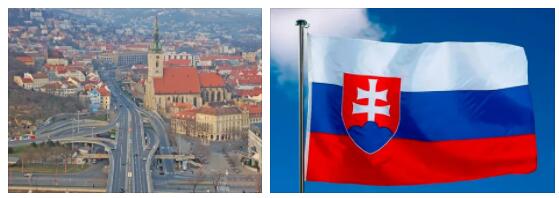Sightseeing
Slovakia has several characteristics that make it an attractive country from a tourism point of view. It has numerous winter sports centers, historic cities, picturesque castles, caves, unique wooden churches, national parks and other natural riches and landscapes. About 40% of Slovakia is covered by forests. Slovak forests are rich in fauna, including brown bears, wolves, lynxes, foxes, wild boars, rabbits, squirrels, polecats, beavers, and muskrats. In mountainous areas you can see chamois(Rupicapra rupicapra) and alpine marmots. Slovakia has a very high percentage of national parks and other protected areas.
One of the main attractions in Slovakia is the Tatra Mountains (which are divided into the High Tatras and the Low Tatras), which are the highest area in the Carpathians. There you can observe interesting native species of fauna and flora, as well as offering numerous options for skiing, mountain walks and rock climbing.
Kayaking and canoeing on the rivers and streams of Slovakia is very popular. There is also a long tradition of using rafts, especially on the Dunajec River.
The seven wonders of Slovakia of great tourist attraction are:
Slovak caves
Slovakia with its more than 5000 caves has a unique underground landscape. This fact was recognized by UNESCO when inscribing the caves of the Slovak Carst together with those of the Hungarian aggtelek as a world heritage site. Among the most impressive caves with access to the public in Slovakia are the ice cave of Dobšina, the Aragonite cave of Ochtina (the only one in the world with access to the public) and the karst cave of Domica,
The altar of the teacher Pablo de Levoča
In the city of Levoča (UNESCO) is the church of St. Jacob and in it the highest wooden Gothic altar in the world. This altar was made by the master Pablo de Levoča in the s. XVI, who finished his work completely blind. Apart from this altar there are, in this church, other very beautiful altars by the same author.
Spis Castle (the largest castle in Central Europe)
In eastern Slovakia are the well-preserved ruins of a majestic castle, Spiš Castle (UNESCO), was the administrative and military center of this region. It is a place that is worth visiting.
St. Elizabeth’s cathedral in Kosice
Slovakia is the place where the influence of the Catholic Church intersects with the Orthodox Church, also accompanied by the Greco-Roman Church (a Catholic church that uses Byzantine worship, they recognize the Pope but have their own bishops). In the city of Košice is the last Gothic cathedral to the east. Gothic art in Europe reached this place. This is also the largest church in Slovakia.
The largest wineries in Central Europe
The Červený Kameň or Red Stone Castle was rebuilt by the Fuger bankers for their mineral business from the Slovak mines. This castle is famous for its immense cellars built to house minerals but used to store wine. The cellars are used in motion pictures to film castle interiors. Here a version of Count Dracula was signed
The Andy Warhol Museum of Modern Art
Andy Warhol, the inventor of Campbel Soups and many other works of art and considered the father of Pop Art, was born in the United States but his parents were of Slovak origin. In the eastern Slovak town of Michalovce there is the only modern art museum dedicated to Andy Warhol in Europe.
Lake Štrbské Pleso in the High Tatras National Park
The High Tatras mountains are the smallest mountain ranges in the world. Among its main attractions are the Štrbské Pleso mountain lake. This was the only place in Slovakia to be among the semifinalists of the election of the 7 new wonders of the world.
Demography
People: Slovaks represent 85.7% of the population while Hungarians constitute the largest ethnic minority: 10.6%. Other ethnic groups include Gypsies, Czechs, Ukrainians, Germans, and Poles. Religion: Catholics 60.3%, non-religious and atheists 9.7%, Slovak Evangelicals 6.2%, Protestants 3.5%, Greek Catholics 3.4%, Orthodox 0.7%, others 18%.
Slovakia has a population of 5,447,000 residents (2007). Life expectancy is 74.9 years. 99.6% of the population is literate. The average number of children per woman is only 1.33.
According to Andyeducation, the official language of the state is Slovak, which belongs to the Slavic family of languages, but Hungarian (11%) is widely spoken in the south and enjoys co-official status in some regions; Ukrainian, Roma and some others are also spoken.
Economy
Slovakia is a state that belongs to the European Union since May 1, 2004 and adopted the euro as its official currency as of January 2009. This fact gives stability, and if we add to it that it has much lower salaries than those of Germany, France or Spain, it causes many factories installed in Western Europe to move to this country, so much so that today it is already a great automotive power. The rate of economic growth of this country in 2005 was (6.1%). Slovakia has successfully weathered the difficult transition from a centrally planned economy to a modern market economy. As early as 2001, the Slovak government was showing significant progress in stabilizing the macroeconomy and implementing structural reforms, despite the recession in some of its most important export markets. An important set of privatizations has taken place, the banking system is almost entirely in the hands of foreign banks, and levels of foreign investment have grown.
